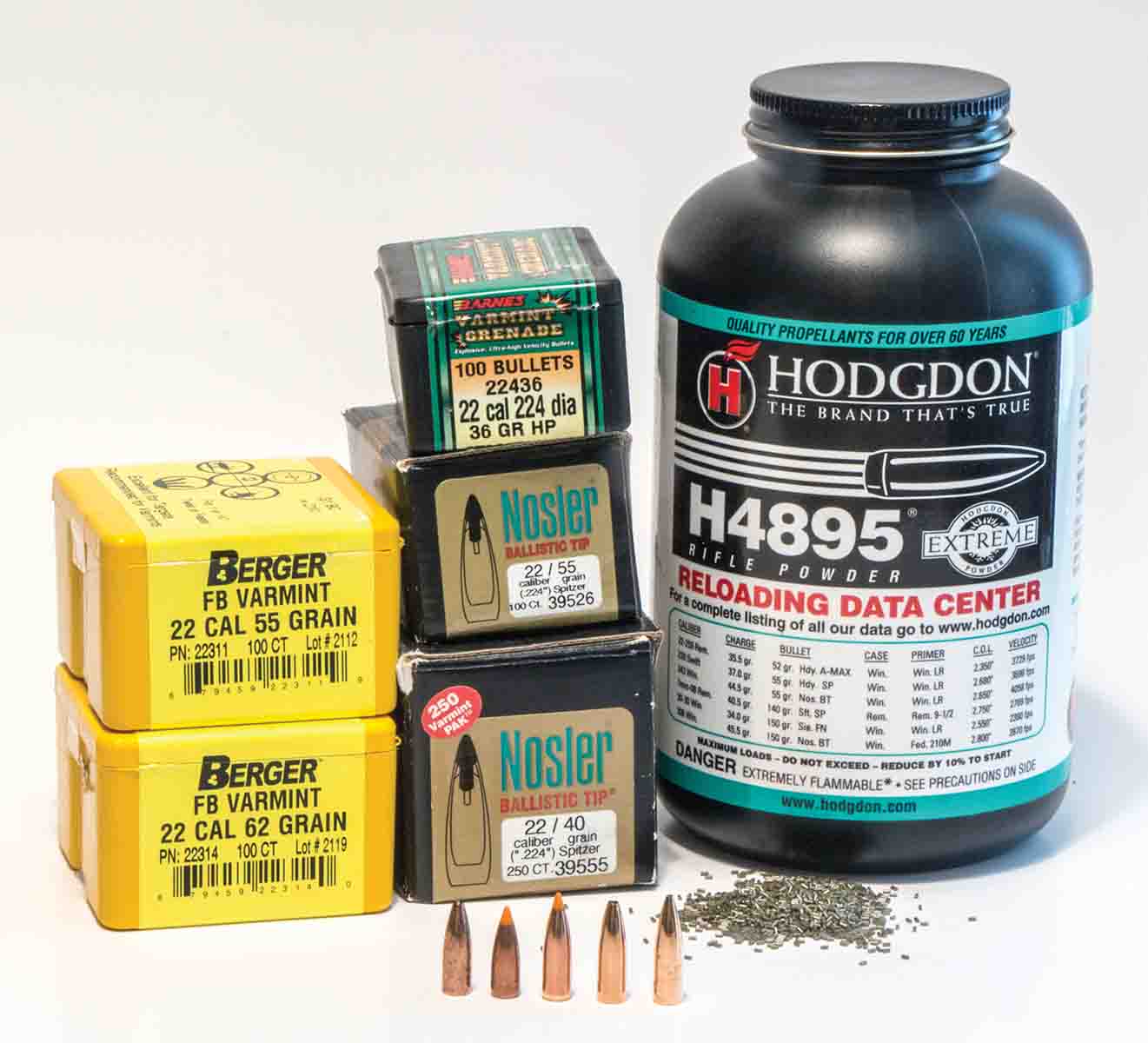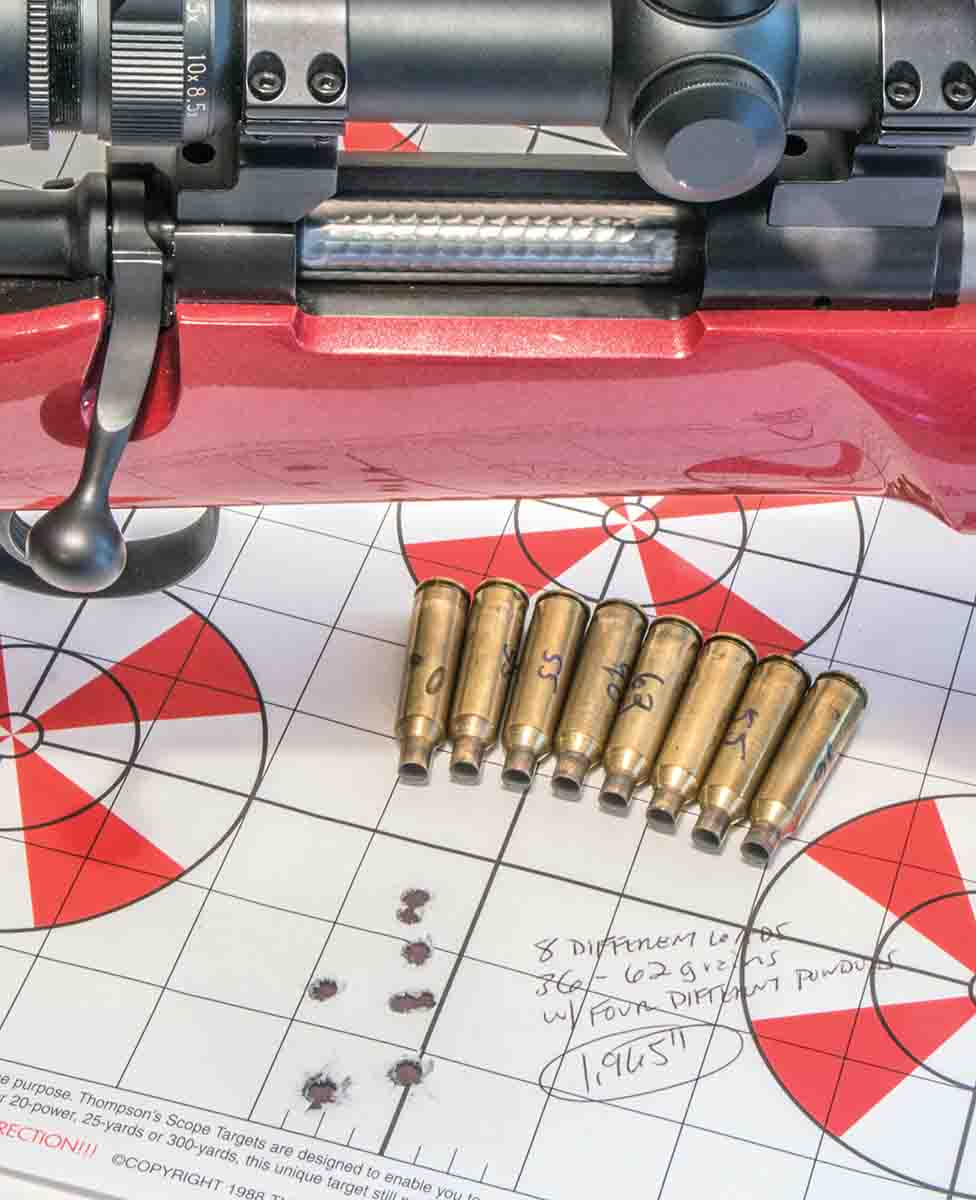A Top Trio
Powders to Cover the .223 and .22-250 Remingtons and the .243 Winchester
other By: Richard Mann | February, 26

The term “varmint rifle” can be a bit subjective. Part of the problem is that, to some, a varmint is nothing more than a gopher or prairie dog, while to others it might be anything from a ground squirrel to a feral hog. The same confusion can apply to rifles. My first centerfire “varmint rifle” was a .270 Winchester, mostly because it was the only rifle I had. I handloaded 100-grain bullets, and it worked admirably on groundhogs. Today varmint shooters use much smaller calibers and cartridges.
Any rifle weighing more than seven pounds scoped is viewed as an anchor, but I’ll make an exception and accept a 10-pound rifle, if I’m carrying it from the truck to a shooting bench set up on a prairie dog town a few yards away. Most of my personal rifles are not very heavy and were made in West Virginia by New Ultra Light Arms (NULA). I’ve owned or used more than a dozen NULAs, including a .243 Winchester, which is perfect for coyote, fox or bobcat calling, or for walking the edges of pastures or fields looking for groundhogs. It is one of three rifles used for developing the loads listed here.
The .243 Winchester and Hunter


Some folks say handloading the .243 Winchester can be problematic. I’ve never found that to be true. In fact, I’ve been loading it longer than any other cartridge and have not experienced any of the “weirdness” others complain of. That said, every .243 Winchester I’ve loaded for, including my current NULA, seemed to be picky when it came to bullet seating depth; they seem to shoot better when bullets are close to the lands.
Anyone interested in loading the .243 Winchester should consider investing in an RCBS Precision Mic. This little tool is excellent for establishing the proper seating depth, and it can also be used to fine-tune sizing die adjustments to account for headspace variations. In fact, if you’re serious about accuracy – and most varmint hunters are – an RCBS Precision Mic is a good investment, regardless of the cartridge being loaded.
Over the years I’ve found one powder and several varmint-capable bullets I really like in this cartridge. The Barnes 62-grain Varmint Grenade is perfect for small to midsize varmints, and 47.5 grains of Ramshot Hunter will push it to 3,300 fps from a 22-inch barrel. In some rifles you might see 3,400 fps. From most rifles, recoil is light enough you can watch the bullet impact through the scope. For coyotes or feral hogs, the Barnes 80-grain TTSX and 47 grains of Hunter is deadly.

In this cartridge, Nosler’s 90-grain Ballistic Tip, with its even higher 0.365 ballistic coefficient (BC), will shoot flatly and stand up to the wind. With between 46 and 46.5 grains of Hunter, this bullet has a muzzle velocity of 3,150 fps out of the NULA’s 22-inch barrel, and I’d not hesitate to use it on ground squirrels, coyotes, hogs or deer.
With 54 to 55 grains of Ramshot Hunter behind Nos-ler’s lightest 6mm Ballistic Tip, which weighs 55 grains, it will provide almost 4,000 fps, and if you like exploding ground rodents, this is the bullet. Regardless of the bullet chosen, it should shoot fine in any .243 Winchester that has the industry standard one-in-10-inch twist. That’s not the case with some of the longer 6mm bullets designed for big game.
I’ve had good luck with Hodgdon Hybrid 100V and Superformance in the .243 Winchester, but I’ve found that Ramshot’s Hunter works well with about any bullet weight. Just as importantly, being a spherical powder, it meters exceptionally well, and this helps with loading consistent ammunition. It’s the powder I start with anytime I’m working up a new load for a .243 Winchester, for any purpose.
Hunter is a double-base powder that burns cleanly. It is imported from Belgium and packaged at the Western Powders laboratory in Miles City, Montana. In the Ramshot powder line, Hunter fills the gap between the faster-burning Big Game and the slower-burning Magnum, and it is the only spherical powder in the popular 4350 burn range.
The .223 Remington and X-Terminator


Lots of people think varmint rifles are .22-caliber rifles, and if the ranges are not excessive, that makes sense. In fact, for mass varmint eradication on gopher fields and prairie dog towns, I prefer a .22-caliber rifle. In that respect, the .223 Remington seems to be the perfect choice, because it will not generate so much recoil that I cannot see a hit or miss in the scope.
A few years back I had a NULA in .223 Remington. These rifles are built on an action sized to fit that cartridge; they do not use a .308 Winchester length action with a blocked magazine. This makes them even lighter and handier. For some time that rifle was my go-to rig for just about anything from groundhogs to whitetails, and I was loading a lot of .223 ammunition back then, because my wallet was rather thin.
As much loading as I did for that light, little .223 Remington, I did not experiment with a lot of bullets or powders. When you find something that works, there’s not a lot of reason to change. For the same reason I like Hunter in the .243 Winchester, I like Ramshot X-Terminator in the .223. It seems to work with any bullet weight, and being a spherical powder like Hunter, it meters smoothly.
I’ve always preferred Nosler 55-grain Ballistic Tips for groundhogs, rockchucks and predators. If feral hogs are the targets, the 60-grain Partition is the way to go. I even used that little rifle in Africa on warthogs. The lighter 40-grain Ballistic Tips are great on gophers and such, but due to their inability to buck wind, I tend to stick with the 55s. My NULA has a one-in-10 twist, which worked great for bullets weighing less than 60 grains. With the heavier bullets, particularly the 60-grain Nosler Partition, accuracy was not outstanding but was still sufficient for shots on coyotes and such out to around 200 yards.
Like Hunter, X-Terminator is a double-base powder that burns cleanly. It too is imported from Belgium and packaged at the Western Powders laboratory in Montana. In the Ramshot line of rifle powders, X-Terminator is the fastest powder sold and it is, by my best scientific guess, just slightly faster than Ramshot TAC.

For a handloader who doesn’t have a lot of experience loading the .223 Remington and wants to be able to use any brass, invest in a primer pocket swaging tool. Lots of factory .223 Remington/5.56 NATO brass has crimped-in primers, and the only way to seat a new primer is after the pocket has been swaged to an appropriate shape. RCBS makes a great tool for this, and while it might be time consuming, it can allow a shooter to use a larger variety of .223/5.56 brass.

The .22-250 Remington and H-4895
Lately I’ve been shooting the heaviest NULA rifle I’ve ever fired. It’s an 8.5-pound varmint/bench-style .22-250 Remington that weighs 10 pounds with an 8.5-24x Leupold VX-III scope attached. I’ve not done a lot of loading for the .22-250, mostly because I figured if I could not get the job done with a .223 Remington or a .243 Winchester, there was no need.
For handloading advice on the .22-250 Remington, I called Charlie Sisk at Sisk Rifles. Sisk does a lot of handloading for himself and his customers and has experience with most every common cartridge and a lot of wildcats. Sisk suggested H-4895 for the .22-250. I took the advice and put together eight different handloads using four different bullet weights. For five of those loads, H-4895 was used. Several other powders were used for the other three loads.

It appears Sisk knows his stuff. With the exception of the Barnes 36-grain Varmint Grenade, all the H-4895 loads gave sub-MOA, five-shot results at 100 yards. That’s pretty good considering that when putting the loads together I simply picked sub-maximum powder charges and seated the bullets where they looked right, and fired three, five-shot groups with each load.
For these random loads, velocity deviations averaged in the mid-20s with H-4895. Using other powders, a varmint shooter might reduce standard velocity deviations a bit. For example, some shooters suggest that with heavier bullet weights – 60 grains and above – slower powders like H-414, Hybrid 100 V or Superformance might be better choices. For what it’s worth, with a 62-grain bullet and Superformance powder, this was not the case in this experiment. Standard velocity deviations were similar to those with the same bullet loaded ahead of H-4895.
Why are lower standard deviations important? Accuracy. At 100 yards a .5-inch group is good enough for any varmint hunting. However, a standard velocity deviation of 25 fps can equate to a maximum velocity deviation perhaps as much as 100 fps. A 100-fps velocity variation at 500 yards can open groups by 4 inches or more, depending on a bullet’s ballistic coefficient. That’s enough to miss low on a prairie dog.
The 62-grain bullets shot very well even though the NULA’s barrel had a one-in-14-inch twist, but the most interesting discovery with the heavy-barreled rifle was how it shot all these loads to almost the exact point of impact at 100 yards. I noticed this during the testing and went back and loaded one more round of each load, not just the H-4895 loads. I fired these eight shots at the same point of aim, and the resulting eight-shot group measured 1.9 inches, and that was with four different powders, five different bullets ranging from 36 to 62 grains and a velocity spread of 800 fps. Impressive!
Hodgdon’s H-4895 is an extremely versatile powder, suitable for use in the .223 Remington, .22-250 Remington and the .243 Winchester. In fact, you could put together good loads for all three of these cartridges – or just about any other rifle cartridge – and never use another powder. It also works very well for reduced loads. The only thing I’ve noticed with H-4895 is that velocity can become erratic with heavily compressed loads.
Unlike days of old, when load manuals or experienced handloaders were the source for load data, today you can find all the load data you need right on the Internet – a caveat being that it must be from a reliable source, such as powder manufacturers. Ramshot has all its load data available online in a printable format, and Hodgdon has a very user friendly, searchable database for almost every cartridge.
What these libraries don’t reveal is which powders or loads have proven to be very consistent or accurate in most firearms. The best way to figure this out is to experiment on your own. This, of course, is not a bad thing, and the resources listed above are a nice place to start.


